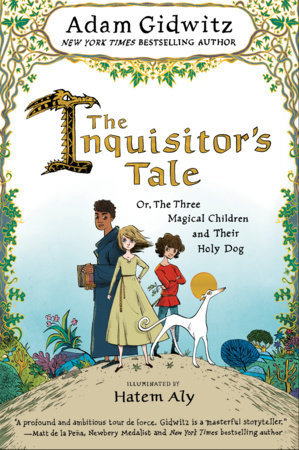MMGM: The Inquisitor's Tale by Adam Gidwitz
ABOUT THE BOOK
An exciting and hilarious medieval adventure from the bestselling author of A Tale Dark and Grimm.
1242. On a dark night, travelers from across France cross paths at an inn and begin to tell stories of three children. Their adventures take them on a chase through France: they are taken captive by knights, sit alongside a king, and save the land from a farting dragon. On the run to escape prejudice and persecution and save precious and holy texts from being burned, their quest drives them forward to a final showdown at Mont Saint-Michel, where all will come to question if these children can perform the miracles of saints.
Join William, an oblate on a mission from his monastery; Jacob, a Jewish boy who has fled his burning village; and Jeanne, a peasant girl who hides her prophetic visions. They are accompanied by Jeanne's loyal greyhound, Gwenforte . . . recently brought back from the dead. Told in multiple voices, in a style reminiscent of The Canterbury Tales, our narrator collects their stories and the saga of these three unlikely allies begins to come together.
Beloved bestselling author Adam Gidwitz makes his long awaited return with his first new world since his hilarious and critically acclaimed Grimm series. Featuring manuscript illuminations throughout by illustrator Hatem Aly and filled with Adam’s trademark style and humor, The Inquisitor's Tale is bold storytelling that’s richly researched and adventure-packed.
Beautifully illustrated throughout! Includes a detailed historical note and bibliography.
REVIEW
To be honest, I'm still processing this book. There were things I really liked about it, and other things I wasn't so sure about. Gidwitz does a fabulous job telling the story. Using secondary characters to tell the story gives the events of the story a rather unusual perspective or perspectives, I should say. The way the inquisitor's story eventually merges with that of the children makes for an interesting subplot. But of course, the focus is indeed on the children and the experiences that bring them together.
Jeanne, a young peasant girl who has visions of the future has to flee her home when she joins forces with Gwenforte, the resurrected dog who saved her life as a baby. Knights have been sent to kill the dog and destroy the grave because the locals have been reported 'worshipping' the animal. William is sent away from the monastery that has been his home for eleven years after he breaks a stone bench with his fist (he's a very large biracial boy with half African roots, which leads him to stand out in medieval France). And poor Jewish Jacob flees his home when his village is set aflame by some cruel and misguided so-called Christian youth. The children do not trust each other at first since they come from such different backgrounds.
It's the way the children learn to befriend and trust each other despite their drastic differences that really made the book for me. It wasn't the miracles or special abilities that made the children stand out the most to me, it was the way they overcame the prejudices of the time to care about and support each other. This allows them to unite to accomplish an almost impossible task, a task that puts them at great risk of martyrdom when they anger the Queen Mother and King of France.
I can't really review the illustrations because the e-book didn't really do them justice, but they looked like the sort of illumination that monks used to create books during the Middle Ages.
While some of the events of the story are a bit fantastical as they are based on legends (depending on your religious beliefs), other parts of the story are based on actual fact. It was fascinating to read the author's note explaining the real parts of the story, the legends merged into the story, and the inspiration that led the author to write the story in the first place.
Religion does play a key role in this story, several religions as a matter of fact: Christian predominately but also Judaism and Islam. I did find it odd that there was so much swearing using God's name considering the beliefs of the characters. And the portrayal of Christianity was a study in contrasts with some of the characters behaving in a Christlike manner and others not much at all. It's the relationships between the children that offers hope for a world that didn't accept differences and tended to encourage the use of force in getting others to agree with you.
While I enjoyed the book for the most part, I'm not sure how many children will pick this book up. Historical fiction is a hard sell at the best of times. An historical novel based in the Middle Ages that's as long as this one is, with such strong religious themes running through it, makes it a difficult book to get children to pick up. I'd be interesting in hearing the opinions of children who've read the book.




Comments
Post a Comment